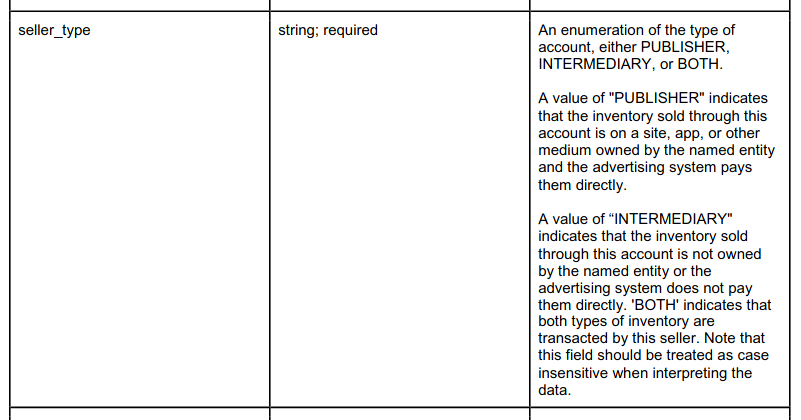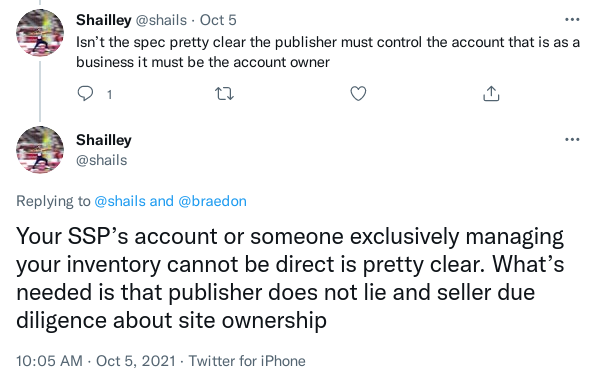Ad Specs Part 2: Sellers and Supply Chains
This is part 2 in a series on IAB Tech Lab adtech standards. Read part 1 here.
In the previous post I covered the ads.txt standard, proposing that the account relationship field be re-defined so that DIRECT accounts could only be used on a single site. This change would enable the industry to clean up mislabelled accounts and help tackle domain spoofing.
But it’s been over 4 years since ads.txt was released, and in the meantime it’s been joined by a pair of newer standards — sellers.json and SupplyChain object. Let’s take a look at these standards, and how they fit in with the proposed ads.txt update.
The Sellers.json Specification
Ads.txt exposes what accounts are authorized to sell a site’s inventory, but very little about the accounts themselves.
In July 2019 the IAB Tech Lab released the sellers.json standard. Where ads.txt is quite limited in its focus — tackling domain spoofing — sellers.json has more nebulous goals. It exposes extra information about the accounts used to sell ad inventory, in service of a “transparent marketplace”.


Sellers.json files are hosted by “ad systems” (sales houses, SSPs, ad exchanges, etc.), and list details of all the accounts used to sell ad inventory via each system.
These accounts are the same as the accounts listed in ads.txt files. In theory, the details for any account in an ads.txt should be able to be looked up in the relevant ad system’s sellers.json file.
The core information provided is the name of the company that is paid when inventory is sold via the account, along with its domain if it has one. Accounts can be marked as “confidential”, in which case these fields are omitted.

Each account also has a “type”. If the company getting paid by the ad system (i.e. listed in the name and domain fields) owns the inventory being sold, it’s a PUBLISHER account. If the inventory is owned by a different company, it’s an INTERMEDIARY account. BOTH accounts sell both types of inventory.

PUBLISHER and INTERMEDIARY seem quite similar to DIRECT and RESELLER from ads.txt, but the definitions are based on different concepts — payment vs. control — so they don’t always align.
A small example sellers.json file for a fictional ad exchange:
{
"contact_email": "admin@exchange1.com",
"contact_address": "Exchange One Inc., 1 Queen St, London, United Kingdom",
"version": "1.0",
"sellers": [
{
"seller_id": "foo",
"name": "Publisher One",
"domain": "publisher1.com",
"seller_type": "PUBLISHER"
},
{
"seller_id": "bar",
"name": "Sales House One",
"domain": "saleshouse1.com",
"seller_type": "INTERMEDIARY"
},
{
"seller_id": "baz",
"name": "SSP One",
"domain": "ssp1.com",
"seller_type": "INTERMEDIARY"
},
{
"seller_id": "ekki",
"name": "Exchange Two",
"domain": "exchange2.com",
"seller_type": "INTERMEDIARY"
}
]
}
The SupplyChain Object Specification
Ad buyers have traditionally only been able to see the account they are buying off — the “last seller”. When buying direct, it’s this last seller account that needs to be DIRECT.
The SupplyChain object OpenRTB extension was released alongside sellers.json. It adds a list of upstream accounts to bid requests, enabling buyers to see the other accounts the inventory has passed through. For “complete” SupplyChains, this list starts all the way back at the “first seller” — the account of the site owner.

Once again, these are the same accounts as those in ads.txt and sellers.json files. Any account in a SupplyChain object should be authorized in the site’s ads.txt, and be listed in a sellers.json file.
An example SupplyChain object for an RTB request on our fictional ad exchange:
{
"ver": "1.0",
"complete": 1,
"nodes": [
{
"asi": "ssp1.com",
"sid": "123",
"hp": 1
},
{
"asi": "exchange1.com",
"sid": "bar",
"hp": 1
}
]
}
Scenarios
Now we’ve covered what sellers.json and SupplyChain objects are, let’s take a look at how they interact with the proposed ads.txt update. I’ll focus on two scenarios that are affected by the new definition of DIRECT.
Sales Houses
Sites that use a sales house to sell their inventory often list all the sales house’s accounts with downstream ad systems as DIRECT. This wouldn’t be allowed under the updated definition.
The site must list the sales house’s accounts with downstream ad systems as RESELLER. The sales house should create a dedicated PUBLISHER account for the site in its sellers.json, with the domain set to the site domain. The site can then list their account with the sales house as DIRECT.
saleshouse1.com/sellers.json:
{
"contact_email": "admin@saleshouse1.com",
"version": "1.0",
"sellers": [
{
"seller_id": "1111",
"name": "Site One",
"domain": "site1.com",
"seller_type": "PUBLISHER"
}
]
}
site1.com/ads.txt:
saleshouse1.com, 1111, DIRECT
exchange1.com, bar, RESELLER
Site One SupplyChain object:
{
"ver": "1.0",
"complete": 1,
"nodes": [
{
"asi": "saleshouse1.com",
"sid": "1111",
"hp": 1
},
{
"asi": "exchange1.com",
"sid": "bar",
"hp": 1
}
]
}
Note that while this is a change from how many sales houses are set up currently, it’s actually what they should be doing already. This was confirmed by a representative of the IAB Tech Lab in response to the previous post. The new definition of DIRECT simply clarifies this scenario.

Multi-Site Publishers
Publishers that own multiple sites often have a single set of accounts with downstream ad systems that are listed as DIRECT by all the sites. This wouldn’t be allowed under the updated definition. To keep using these shared accounts, the publisher would need to act as an ad system.
Each site must list the publisher’s accounts with downstream ad systems as RESELLER. The publisher should create a sellers.json containing a PUBLISHER account for each site, with the domains set appropriately. The sellers.json must be hosted on the domain used in the publisher’s accounts. Each site can then list their account with the publisher as DIRECT.
publisher1.com/sellers.json:
{
"contact_email": "admin@publisher1.com",
"version": "1.0",
"sellers": [
{
"seller_id": "aaaa",
"name": "Site A",
"domain": "site-a.com",
"seller_type": "PUBLISHER"
},
{
"seller_id": "bbbb",
"name": "Site B",
"domain": "site-b.com",
"seller_type": "PUBLISHER"
}
]
}
site-a.com/ads.txt:
publisher1.com, aaaa, DIRECT
exchange1.com, foo, RESELLER
Site A SupplyChain object:
{
"ver": "1.0",
"complete": 1,
"nodes": [
{
"asi": "publisher1.com",
"sid": "aaaa",
"hp": 1
},
{
"asi": "exchange1.com",
"sid": "foo",
"hp": 1
}
]
}
site-b.com/ads.txt:
publisher1.com, bbbb, DIRECT
exchange1.com, foo, RESELLER
Site B SupplyChain object:
{
"ver": "1.0",
"complete": 1,
"nodes": [
{
"asi": "publisher1.com",
"sid": "bbbb",
"hp": 1
},
{
"asi": "exchange1.com",
"sid": "foo",
"hp": 1
}
]
}
Supply Path Optimisation
These account labelling changes will reduce the number of sites with DIRECT last seller accounts. This could result in a significant shift in ad supply and demand if buyers continue to prioritise buying direct.
If these buyers legitimately don’t want to buy from any intermediary, then this would simply be buyers actually getting what they thought they were buying all along. But it’s possible many buyers would be OK with certain indirect paths, if they could target them.
Buying direct is effectively using the ads.txt relationship field for a type of Supply Path Optimisation (SPO). But it’s a binary field — paths are direct or indirect. It just isn’t a good tool for the job, regardless of how it’s defined.
The SupplyChain object is clearly a better tool for SPO. With it, a buyer can check that all the accounts are authorized in the site’s ads.txt, not just the last seller. They can check the first seller is DIRECT. They can look them up in sellers.json files to see who the intermediaries are, who the first seller was, and determine whether they trust them.
You get the picture. SupplyChain objects, combined with data from sellers.json and ads.txt files, enable far more sophisticated SPO than the ads.txt relationship field ever could. With this kind of SPO, the importance of the last seller account being DIRECT is significantly reduced. A valid SupplyChain with trustworthy intermediaries could be just as valuable as a DIRECT account, depending on the buyer.
We should be aiming to get buyers using SupplyChain, rather than worrying about whether sites can be bought direct.
Is DIRECT Needed?
At this point, you may be wondering if it’s worth updating the definition of DIRECT at all. If buyers should be checking SupplyChains rather than buying direct, does DIRECT mislabelling matter? Do we need the ads.txt relationship field?
If ads.txt was still being drafted, I think there’d be a good argument for simply not including the relationship field. But ads.txt has been in the wild for 4 years, and the relationship field is being actively used by buyers. That’s not going to change overnight.
Using SupplyChain for SPO is not something new I’m proposing — that’s what it was designed for, and it was released over two years ago. Buyers are going to keep buying direct for some time yet, and I think it’s important to make sure they start getting what they’ve been paying for.
Even once using SupplyChains is standard and the direct/indirect binary is a thing of the past, buyers will need to validate those SupplyChains against information from sellers.json and ads.txt files. With its updated definition, the ads.txt relationship field provides information that isn’t available elsewhere: whether the account is specific to a site. This information is important for assessing the risk of domain spoofing by authorized accounts.
Sellers.json focuses on who gets paid for inventory, not what site it’s from. It could be updated to incorporate this information — something I think we should consider — but that is a much bigger change.
A Way Forward
DIRECT mislabelling has been a long standing issue with ads.txt. Cleaning it up is essential to weeding out fraud, and building a level playing field for legitimate publishers.
Narrowing the definition of DIRECT to enable this clean-up will impact some sites, but only while buying direct remains a prominent strategy. SupplyChain objects, paired with sellers.json and ads.txt, give buyers the data required to move away from this reliance.
Transparent, accurate supply chains are better for both advertisers and publishers. If you’re an advertiser, talk to your agency/DSP about utilizing SupplyChain object data in your campaigns. If you’re a publisher, check your ads.txt for mislabelled accounts and develop a plan for correcting them.
Changes like this won’t happen overnight, but the sooner we start, the better.